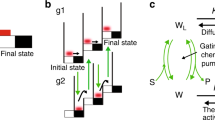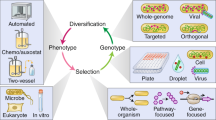Abstract
THE tertiary structure of an isolated polypeptide chain may differ from its most stable conformation as a component of an oligomer. The assembly of free subunits into an oligomeric structure may therefore involve a relatively unstable oligomeric intermediate state in which the conformation of the subunits corresponds to that of the free polypeptide chains. Such a metastable intermediate state may be separated from the stable oligomer by a substantial energy barrier, and the marked temperature dependence of subunit association reactions has indeed been attributed to the existence of a “conformational transition state”1.
This is a preview of subscription content, access via your institution
Access options
Subscribe to this journal
Receive 51 print issues and online access
$199.00 per year
only $3.90 per issue
Buy this article
- Purchase on Springer Link
- Instant access to full article PDF
Prices may be subject to local taxes which are calculated during checkout
Similar content being viewed by others
References
Monod, J., Wyman, J., and Changeux, J. P., J. Mol. Biol., 12, 88 (1965).
Hatfield, G. W., and Burns, R. O., Science, 167, 75 (1970).
Hatfield, G. W., and Burns, R. O., Proc. US Nat. Acad. Sci., 66, 1027 (1970).
Ling, K. H., Marcus, F., and Lardy, H. A., J. Biol. Chem., 240, 1893 (1965).
Mansour, T. E., J. Biol. Chem., 240, 2165 (1965).
Hofer, H. W., and Pette, D., Z. Physiol. Chemie, 349, 1105 (1968).
Uyeda, K., and Racker, E., J. Biol. Chem., 240, 4682 (1965).
Hizukuri, S., and Lamer, J., Biochemistry, 3, 1783 (1964).
Steiner, D. F., Younger, L., and King, J., Biochemistry, 4, 740 (1965).
Pogson, C. I., Biochem. J., 110, 67 (1968).
Cazzulo, J. J., Sundaram, T. K., and Kornberg, H. L., Nature, 227, 1103 (1970).
Cazzulo, J. J., Sundaram, T. K., and Kornberg, H. L., Nature, 223, 1137 (1969).
Feigelson, P., Feigelson, M., and Greengard, O., Rec. Prog. Hormone Res., 18, 491 (1962).
Piras, M. M., and Knox, W. E., J. Biol. Chem., 242, 2952 (1967).
Freundlich, M., and Umbarger, H. E., Cold Spring Harbor Symp. Quant. Biol., 28, 505 (1963).
Feigelson, P., and Maeno, H., Biochem. Biophys. Res. Commun., 28, 289 (1967).
Gest, H., and Mandelstam, J., Nature, 211, 72 (1966).
Zwaig, N., and Lin, E. C. C., Science, 153, 755 (1966).
Paulus, H., and Gray, E., J. Biol. Chem., 243, 1349 (1968).
Patte, J. C., Loviny, T., and Cohen, G. N., Biochim. Biophys. Acta, 99, 523 (1965).
Chilson, O. P., Kitto, G. B., Pudles, J., and Kaplan, N. O., J. Biol. Chem., 241, 2431 (1966).
Deal, W. C., Biochemistry, 8, 2795 (1969).
Kohn, L. D., J. Biol. Chem., 245, 3850 (1970).
Author information
Authors and Affiliations
Rights and permissions
About this article
Cite this article
ALPERS, J., PAULUS, H. Biological sciences: Allosteric Preconditioning: Role of Allosteric Ligands in Promoting the Maturation of Enzymes. Nature 233, 478–480 (1971). https://doi.org/10.1038/233478a0
Received:
Issue Date:
DOI: https://doi.org/10.1038/233478a0
This article is cited by
-
Models of buffering of dosage imbalances in protein complexes
Biology Direct (2015)
-
Glutamate dehydrogenases from chlorella: Forms, regulation and properties
Molecular and Cellular Biochemistry (1977)
Comments
By submitting a comment you agree to abide by our Terms and Community Guidelines. If you find something abusive or that does not comply with our terms or guidelines please flag it as inappropriate.



